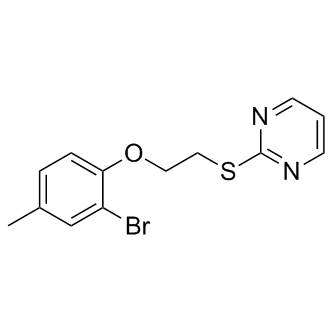
ZLN-024
CAS No. 723249-01-2
ZLN-024( ZLN024 )
Catalog No. M15768 CAS No. 723249-01-2
A novel AMPK allosteric activator that has no effect on mitochondrial function or the ADP/ATP ratio; directly activate recombinant AMPK α1β1γ1 and its homologue α2β1γ1 with EC50 of 0.42 uM and 0.95 uM, respectively.
Purity : >98% (HPLC)
 COA
COA
 Datasheet
Datasheet
 HNMR
HNMR
 HPLC
HPLC
 MSDS
MSDS
 Handing Instructions
Handing Instructions
| Size | Price / USD | Stock | Quantity |
| 5MG | 302 | Get Quote |


|
| 10MG | 447 | Get Quote |


|
| 25MG | 714 | Get Quote |


|
| 50MG | 1017 | Get Quote |


|
| 100MG | 1368 | Get Quote |


|
| 500MG | 2673 | Get Quote |


|
| 1G | Get Quote | Get Quote |


|
Biological Information
-
Product NameZLN-024
-
NoteResearch use only, not for human use.
-
Brief DescriptionA novel AMPK allosteric activator that has no effect on mitochondrial function or the ADP/ATP ratio; directly activate recombinant AMPK α1β1γ1 and its homologue α2β1γ1 with EC50 of 0.42 uM and 0.95 uM, respectively.
-
DescriptionA novel AMPK allosteric activator that has no effect on mitochondrial function or the ADP/ATP ratio; directly activate recombinant AMPK α1β1γ1 and its homologue α2β1γ1 with EC50 of 0.42 uM and 0.95 uM, respectively; also directly activate recombinant AMPK α1β2γ1 (EC50=1.1 μuM) and AMPK α2β2γ1 (EC50=0.13 uM); activates AMPK in L6 myotubes and stimulates glucose uptake and fatty acid oxidation; improves glucose tolerance, liver tissue weight, triacylglycerol and decreases the total cholesterol content in db/db mice (15 mg/kg/day).Diabetes Preclinical.
-
In VitroZLN024 allosterically stimulates active AMPK heterotrimers and the inactive α1 subunit truncations α1 (1-394) and α1 (1-335) but not α1 (1-312). AMPK activation by ZLN024 requires the pre-phosphorylation of Thr-172 by at least one upstream kinase and protects AMPK Thr-172 against dephosphorylation by PP2Cα. ZLN024 activates AMPK in L6 myotubes and stimulates glucose uptake and fatty acid oxidation without increasing the ADP/ATP ratio. Using the established scintillation proximity assay (SPA) assay, random screening against the AMPK α1β1γ1 heterotrimer is performed and a new AMPK activator, ZLN024 is found. ZLN024 directly activates recombinant AMPK α1β1γ1 and its homologue α2β1γ1 in a concentration-dependent manner. ZLN024 increases the activity of α1β1γ1 by 1.5-fold and has an EC50 of 0.42 μM, and it increases the activity of α2β1γ1 by 1.7-fold with an EC50 of 0.95 μM. ZLN024 also directly activates recombinant AMPK α1β2γ1, by 1.7-fold with an EC50 of 1.1 μM; and AMPK α2β2γ1, by 1.6-fold with an EC50 of 0.13 μM.
-
In VivoC57BKS db/db mice are administered a 15 mg/kg/day dose of ZLN024 by daily gavage for 5 weeks; 250 mg/kg/day Metformin (Met) is used as a positive control. During the treatment period, there is no significant alteration in food intake and body weight compared with the vehicle group. After 4 weeks of treatment, ZLN024 improves glucose tolerance. ZLN024 reduces the fasting blood glucose by 15%. Liver tissue weight, triacylglycerol and the total cholesterol content are decreased.
-
SynonymsZLN024
-
PathwayMembrane Transporter/Ion Channel
-
TargetAMPK
-
RecptorAMPK
-
Research AreaMetabolic Disease
-
IndicationDiabetes
Chemical Information
-
CAS Number723249-01-2
-
Formula Weight325.2241
-
Molecular FormulaC13H13BrN2OS
-
Purity>98% (HPLC)
-
Solubility10 mM in DMSO
-
SMILESCC1=CC(=C(C=C1)OCCSC2=NC=CC=N2)Br
-
Chemical NamePyrimidine, 2-[[2-(2-bromo-4-methylphenoxy)ethyl]thio]-
Shipping & Storage Information
-
Storage(-20℃)
-
ShippingWith Ice Pack
-
Stability≥ 2 years
Reference
1. Zhang LN, et al. PLoS One. 2013 Aug 20;8(8):e72092.
molnova catalog



related products
-
MT47-100
A novel potent, allosteric, simultaneously direct activator and inhibitor of AMPK complexes containing the β1 or β2 isoform, respectively.
-
BC1618
BC1618 is an orally active Fbxo48 inhibitory compound, stimulates Ampk-dependent signaling.
-
Gomisin J
Gomisin J is a natural product and have vasodilatory activity.?Gomisin J suppresses lipid accumulation by regulating the expression of lipogenic and lipolytic enzymes and inflammatory molecules through activation of AMPK, LKB1 and Ca2+/calmodulin-dependent protein kinase II and inhibition of fetuin-A in HepG2 cells.



 Cart
Cart
 sales@molnova.com
sales@molnova.com


